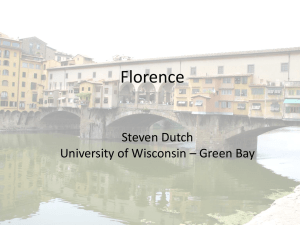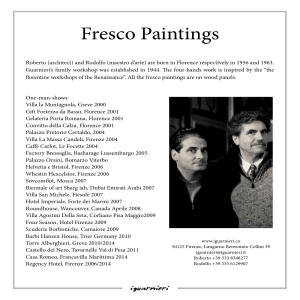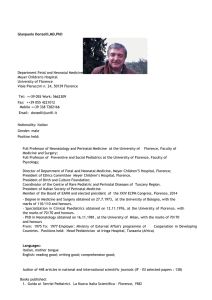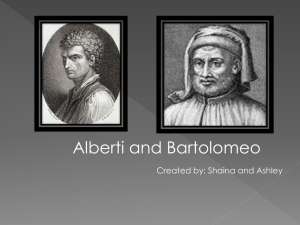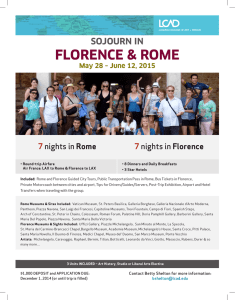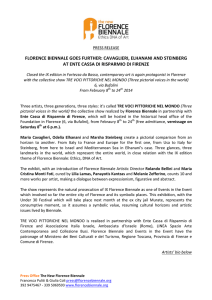lastday - Northwestern University
advertisement
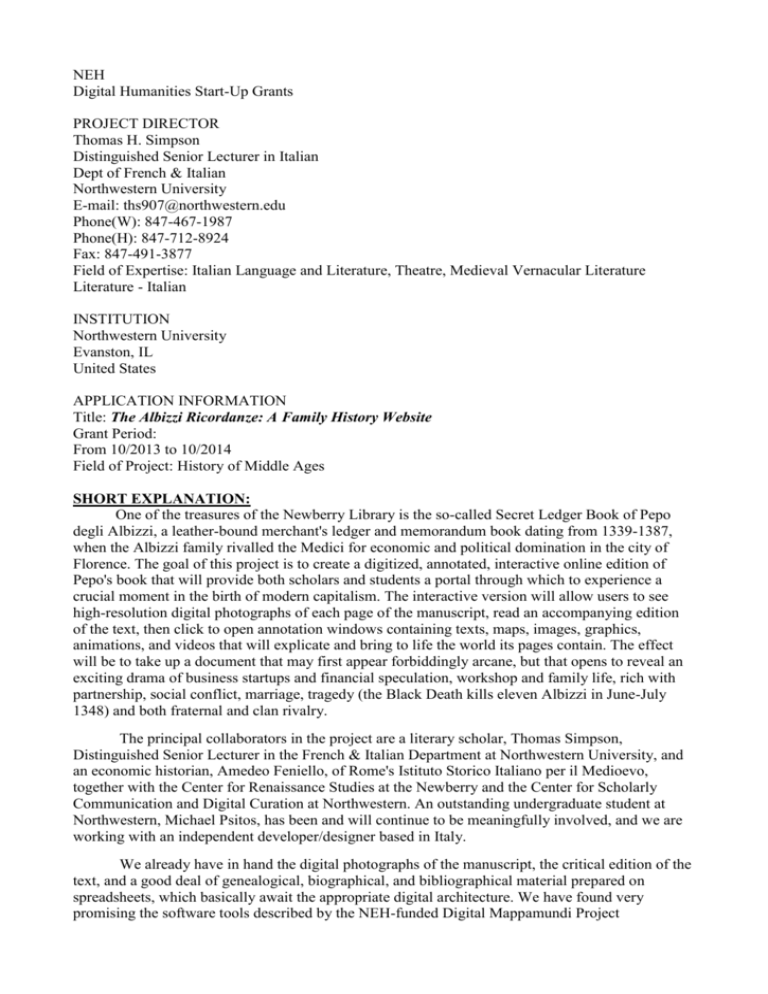
NEH
Digital Humanities Start-Up Grants
PROJECT DIRECTOR
Thomas H. Simpson
Distinguished Senior Lecturer in Italian
Dept of French & Italian
Northwestern University
E-mail: ths907@northwestern.edu
Phone(W): 847-467-1987
Phone(H): 847-712-8924
Fax: 847-491-3877
Field of Expertise: Italian Language and Literature, Theatre, Medieval Vernacular Literature
Literature - Italian
INSTITUTION
Northwestern University
Evanston, IL
United States
APPLICATION INFORMATION
Title: The Albizzi Ricordanze: A Family History Website
Grant Period:
From 10/2013 to 10/2014
Field of Project: History of Middle Ages
SHORT EXPLANATION:
One of the treasures of the Newberry Library is the so-called Secret Ledger Book of Pepo
degli Albizzi, a leather-bound merchant's ledger and memorandum book dating from 1339-1387,
when the Albizzi family rivalled the Medici for economic and political domination in the city of
Florence. The goal of this project is to create a digitized, annotated, interactive online edition of
Pepo's book that will provide both scholars and students a portal through which to experience a
crucial moment in the birth of modern capitalism. The interactive version will allow users to see
high-resolution digital photographs of each page of the manuscript, read an accompanying edition
of the text, then click to open annotation windows containing texts, maps, images, graphics,
animations, and videos that will explicate and bring to life the world its pages contain. The effect
will be to take up a document that may first appear forbiddingly arcane, but that opens to reveal an
exciting drama of business startups and financial speculation, workshop and family life, rich with
partnership, social conflict, marriage, tragedy (the Black Death kills eleven Albizzi in June-July
1348) and both fraternal and clan rivalry.
The principal collaborators in the project are a literary scholar, Thomas Simpson,
Distinguished Senior Lecturer in the French & Italian Department at Northwestern University, and
an economic historian, Amedeo Feniello, of Rome's Istituto Storico Italiano per il Medioevo,
together with the Center for Renaissance Studies at the Newberry and the Center for Scholarly
Communication and Digital Curation at Northwestern. An outstanding undergraduate student at
Northwestern, Michael Psitos, has been and will continue to be meaningfully involved, and we are
working with an independent developer/designer based in Italy.
We already have in hand the digital photographs of the manuscript, the critical edition of the
text, and a good deal of genealogical, biographical, and bibliographical material prepared on
spreadsheets, which basically await the appropriate digital architecture. We have found very
promising the software tools described by the NEH-funded Digital Mappamundi Project
(http://dm.drew.edu/dmproject/) and spoke with one of the project managers last Spring, but since
the beginning of this two-week DH workshop at Northwestern, we've been unable to reach him or
anyone else at DM, and so haven't yet been able to construct a prototype using the DM tools. In the
meantime we have been exploring alternatives such as the Image Markup Tool from the University
of Victoria and the Germany-based TextGrid Project, but neither seems quite able to do what we
have in mind.
DRAFT GRANT PROPOSAL:
Description of Project:
The commercial and personal diary of the merchant-entrepreneur Pepo degli Albizzi, a manuscript
preserved at the Newberry Library, Chicago, provides an important source for the history of Italian
and European culture in the late Middle Ages. We propose to create a free, open-access online
edition of this manuscript that will offer scholars interactive critical and historical tools, including
an extensive historical introduction, high-quality images of the entire manuscript, a full
transcription of its text, annotations, contextual multimedia, and multiple indices. We will take full
advantage of available digital tools to provide a highly complete account of the contents of the
ledger in all its many dimensions—genealogical, family-historical, social and economic, and
paleographical and literary.
BUDGET
Matching Request
Total NEH
$ 80.837
GRANT ADMINISTRATOR
E-mail:
….
Phone(W):
….......
Fax:
….............
Table of contents
1. Table of contents
2. List of participants
3. Humanities significance and statements of innovation
1. The World in a Manuscript
2. The Edition
3. From Birth to Death: The Merchant Diary as a Source for Family History
4. The Website and the innovation
to be completed
5. Work Plan
to be completed
6. Staff
to be completed
7. Final product dissemination
4. Project Budget
5. Biographies
to be completed
6. Selected Bibliography
7. Data Management Plan
8. Letters of Commitment and Support
9. Appendices
to be done
to be done
to be done
2. List of participants
Project Director
Simpson, Thomas H. (Distinguished Senior Lecturer in Italian, Director of Undergraduate Studies
in Italian, Northwestern University)
Software Director
Parod, William (Architect, Software Development Group, Northwestern University)
Software Architect
Matthew Taylor, IT Director, MultiMedia Learning Center, Northwestern University
Digital Projects Consultant
Honn, Josh (Digital Scholarship Library Fellow, Northwestern University)
Web and Motion Graphic Designer
Diamantis, Nicholas (NBC Universal Studios Global Networks Italia, Rome-Italy)
Software Developer
Psitos, Michael (Undergraduate Student, Northwestern University)
Historical Consultant
Feniello, Amedeo (Professor, Istituto Storico Italiano per il Medioevo, Rome-Italy)
3. Humanities significance and statements of innovation
1. The World in a Manuscript
Composed of 92 leaves, Pepo’s ledger cum diary presents a rare personal witness to the history of
Florence between 1339 and 1353, one of the most dramatic moments in early Renaissance history.
These were precisely the “fat years” of Florence’s greatest prosperity, abruptly destroyed by the
Black Death in 1348, and followed by a period of economic decline. Many Florentine merchant
writers kept diaries during this period, but few survive intact. The author of this one, Pepo degli
Albizzi, was an important personage, active in Florence’s signature wool trade, expert in the best
accounting methods of the day (a Tuscan specialty), and actively involved in politics. Pepo in fact
achieved high political office, and together with his kinsmen he created a family dynasty that
challenged the ascendency of the Medici. In short, he was a leading figure in the “Culture of the
Florin,” so-called after the prestigious and widely used currency of Florence and its city-state. As a
historical source, his diary can be compared with the most important of the day—including the
famous and more literary accounts of Giovanni Villani and Giovanni di Pagolo Morelli.
2. The Edition
Our edition of the manuscript text, a collaboration between Thomas Simpson of Northwestern
University and Amedeo Feniello of Istituto Storico Italiano per il Medioevo, follows the best
modern editorial practice, giving a faithful reading of Pepo’s own language and allowing him to
speak to a modern audience. Written in a clear and crisp mercantesca hand, the type of handwriting
most common among commercial writers of fourteenth-century Florence, the text is both a model of
the merchant-diary genre and also a fine specimen of the script that embodied his commercial
culture.
The full transcription we offer will serve teachers and researchers in several important fields:
a. Business and Accounting History: the ledger/diary presents an extended example of the
kinds of accounts kept and contracts entered into by an active wool merchant.
b. Family and Social History: Pepo traces his family’s births, deaths, marriages, alliances,
and partnerships with each other and within the larger Florentine society.
c. Literature: the text juxtaposes family and commercial writing styles in a manner typical
for both in that period.
d. Linguistics and Paleography: the manuscript offers examples of grammatical inflection,
vocabulary, typical merchant’s handwriting, and the use of abbreviations.
3. From Birth to Death: The Merchant Diary as a Source for Family History
The single most interesting aspect of the diary of Pepo degli Albizzi is what we may call its
commercial-familial dimension. The very form of the merchant diary offers a combination of data
about Florentine families of the period as both dynastic and economic units. Pepo’s particularly rich
diary will allow us to reconstruct important data of several types about the Albizzi family and its
world:
a. A reconstructed genealogy of the family, going back to its roots in the thirteenth century
and continuing to the end of the fourteenth. The undisputed kingpin of this extended
family was Pepo’s father Antonio, whose descendants included Pepo’s many siblings,
grandsons and granddaughters, and great-grandchildren.
b. A sense of the family as an economic unit, in which kinship relations and business ones
were often identical. Pepo transcribes contracts between family members in full, so we
can see the relative weight of various members of the partnerships they established to
manufacture and sell woolen cloth and in their ownership of agricultural land.
c. Details about family wealth, both in specific cases and in the aggregate, are included in
the diary as a matter of course. The family’s resources are richly recorded in an
inventory of the family holdings at the time of the plague. The way this patrimony was
distributed among the surviving members, carefully respecting their individual past
contributions and present needs, is of unique interest. Pepo’s diary offers an important
case study of how capital was amassed and preserved.
d. A portrait of family networks, because Pepo carefully records baptismal sponsors and
marriages, each of which involved choices to ally the Albizzi individually and as a
family unit to other prominent Florentine families of the merchant class.
e. A sense of the life-cycle of the late medieval family in an age of demographic
catastrophe. Again, because Pepo is so careful a recorder of the births and deaths of his
three wives, his children, and other relatives, his diary offers a microcosm of Florentine
society in the years before, during, and after the Black Death.
4. The Website
We plan to build an interactive resource with an architecture sophisticated enough to allow visitors
to read the manuscript, to understand its contents within a larger cultural and historical context, and
to study it in great detail. At its heart will be a digital facsimile of the manuscript, page by page,
which may be viewed alone or in parallel with the edited transcription. This split-screen version will
allow visitors to read through the manuscript entry by entry (that is, one logical unit at a time) and
also, for the purposes of paleographical study, a line at a time.
The site will be fully searchable, but since the terminology of the period is unfamiliar to
many potential readers, a full index of names, places, and subjects in English and Italian will be
made available; and individual terms within the transcription will be linked to definitions on the site
and/or to other websites.
The digital transcription of the text will offer an array of critical and historical annotations
organized according to theme, including definitions of terms, biographical sketches, and multimedia
sources including historical maps and audio and video content focusing on varied topics, from book
production to the environmental impact of the wool industry, from marriage practices to the Black
Death.
The site will provide an extensive historical introduction in English and Italian. Within the
English section, key passages of the diary will be translated fully. Also included will be an
interactive genealogical tree of the Albizzi family with links to places in the text of Pepo’s diary, a
full bibliography of articles and books that concern this manuscript and others like it, and a page of
selected links to Florentine and Italian history and literature sites.
An additional possibility, if sufficient funding becomes available, is to include interactive
paleographic tools to assist users in learning to read the original fourteenth-century handwriting.
These could include a tutorial on the script and abbreviations used by Pepo, including historical
information and an overview of the challenges it presents to readers
Digitization and access to the manuscript has been completed and provided by the Newberry
Library in Chicago, IL. Annotation work has begun in various digital forms, most recently in the
formation of a relational database. However, significant work needs to be done linking the digital
transcriptions and translations to the digitized images of the manuscript, and linking annotations to
the text and across the entire manuscript. Having evaluated a number of tools for this work, we
propose a partnership with the DM project in order to use their software as our research
environment.
SOMETHING HERE ABOUT WHERE WE GO FROM DM. EXPORT. CUSTOM
DEVELOPMENT. ETC.
SOMETHING ABOUT INTERACTIVE PIECES: VIDEOS, MAPS, GENEAOLOGIES,
ETC.
Finally, we propose to launch a WordPress site as the online home of the project, in which
we plan to provide an introduction to the project; a blog for updating the public on progress of the
project, including critical reflections and scholarly introductions to various sections and context of
the manuscript; and project documentation.
For the animation:
Cinema-style animations in the website, will invite viewers to experiencce the atmosphere and the
mood of the bustling, spirited city of Florence.
Animations within the project will be built with the industry standard software of Adobe "After
effects Cs6" and the programs of the Adobe suite. "After effects" is a powerful tool for creating
high quality motion graphics.
After Effects animates composite media in 2D and 3D space with various built-in tools and third
party plug-ins, with capability for "Parallax" and user-adjustable angles of observation.
"MAXON Cinema 4d" 3d software will be used For the creation of 3d models and scenes that
integrate with After effects.
All video animations they will be delivered in different formats that can be uploaded in all social
media.
5. Workplan
A. Work on the manuscript/text:
Data Collection (3 months): This phase of the project will consist of data collection and
organization. We will read the manuscript and extract all relevant information on a basic level,
organizing this data into spreadsheet form. Each paragraph of the manuscript will be given a unique
identifier that can be recognized by the chosen program. People, places, recurrent themes, and
economic transactions will be organized into spreadsheet files. By uniquely identifying all the
important elements of the manuscript allows us to map the relevant data. These files will be
interconnected so as to permit shared communication and plotting of annotations and web-based
analysis of the manuscript. This phase of the project consists largely in recreating into the needed
electronic languages, the data in and around the manuscript that we have already developed in
traditional media.
To accompany this process, we will create and edit a WordPress site to describe our project
and report on our ongoing progress.
B. Elaboration of the electronic resource:
Digital Elaboration (6 months): In this phase we will integrate the spreadsheet data into existent
imaging tools such as those being developed in the DM Project, or set up a plan to develop our own
software. Developer and designers will collaborate the authors to create an architecture that is
intuitive, appealing to general viewers, and useful for scholars. A prototype will be published online
for a test period to invite improvements and further development.
C. Publication Phase, Final product and dissemination (12 months): Tools will be built in to allow
scholars to comment on and contribute to the site, according to their areas of expertise, and to allow
teachers to experiment with the site and make suggestions to improve it as a pedagogical tool. The
idea in this phase is to find ways to widen and deepen the authorship of the resource, making it into
a global crossroads of Medieval Studies, where consumers of the site can become participants, and
where teachers and dialogue fruitfully with scholars.
B. For the WEB WORDPRESS, and for motion graphic
TO BE DONE
5. Staff: TO BE COMPLETED
Name and Title
Role
Time commited
Funding
Simpson, Thomas H. Director
(Distinguished Senior
Lecturer in Italian,
Director
of
Undergraduate Studies
in Italian, Northwestern
University)
NEH
Parod,
William Software Director
(Architect,
Software
Development Group,
Northwestern
University)
NEH
Taylor, Matthew, (IT Software Architect
Director, MultiMedia
Learning
Center,
Northwestern
Honn, Josh (Digital Digital Consultant
Scholarship
Library
Fellow, Northwestern
University)
NEH
Diamantis,
Nicholas Web
and
Motion
(NBC
Universal Graphic Designer
Studios
Global
Networks Italia, RomeItaly)
NEH
Psitos,
Michael Software Developer
(Undergraduate
Student, Northwestern
University)
Feniello,
Amedeo Historical Consultant
(Professor,
Istituto
Storico Italiano per il
Medioevo, Rome-Italy)
4. Budget
160 hours
NEH
Budget Form
OMB No 3136-0134
Expi res 7/31/2015
Applicant Institution: Northwestern University
Project Director: Thomas Simpson
Project Grant Period: 05/01/2013-04/30/2014
click for Budget Instructions
Computational
Details/Notes
(notes) Year 1
(notes) Year 2
05/01/201304/01/2014
(notes) Year 3
01/01/20__12/31/20__
Project Total
01/01/20__12/31/20__
1. Salaries & Wages
9-month Academic base
salary: $59,400. Requesting
1.75 months of summer
salary, or 58%.
%
12-month salary: $116,970.
Requesting 0.24 months of
Bill
JoshParod,
Honn,Software
SoftwareArchitect academic salary, or 2%.
%
Thomas Simpson, Project
Director
Architect
Nikos Diamantis, Web
designer
Michael Psitos,
Undergraduate Student,
Software Devleoper
130 hours @ $25/hour.
Plus 30 hours @
$25/hour for the start up
2. Fringe Benefits
Project Director Thomas
Simpson
26.2% of funded portion
of salary
26.2% of funded portion
Bill Parod,
Josh
Honn,Software
SoftwareArchitect of salary
Architect
Nikos Diamantis, Web
designer
3. Consultant Fees
Amedeo Feniello
$11.550 %
%
$11.550
$2.339 %
$2.382 %
%
%
%
$2.339
$2.382
%
$3.960 %
%
$3.960
%
$4.000 %
%
%
%
%
$4.000
$0
$3.134
$3.134
$635
$646
$1.040
$1.040
$15.000
$15.000
$10.000
$10.000
$0
$5.000
$5.000
4. Travel
5. Supplies & Materials
Manuscripts digitation
6. Services
$0
7. Other Costs
$0
8. Total Direct Costs
Per Year
$59.686
$0
$0
$59.686
9. Total Indirect Costs
Indirect Cost Calculation:
a. Rate: 54.5% of direct cost
per year.
b. Federal Agency: DHHS
c. Date of Agreement:
Per Year
8/30/2013
$21.151
$0
$0
$21.151
(Direct and Indirect costs for entire project)
$80.837
10. Total Project Costs
11. Project Funding
a. Requested from NEH
b. Cost Sharing
12. Total Project Funding
Outright:
Federal Matching Funds:
TOTAL REQUESTED FROM NEH:
$80.837
$0
$80.837
Applicant's Contributions:
Third-Party Contributions:
Project Income:
Other Federal Agencies:
TOTAL COST SHARING:
$0
$0
$0
$0
$0
$80.837
5. Biographies
Simpson, Thomas H.
Distinguished Senior Lecturer in Italian, Director of Undergraduate Studies in Italian, PhD U. of
Chicago. Teaches both literature/culture and language. Research areas include: vernacular Middle
Ages, 19 century journalism and post-Risorgimento culture, Theatre from early modern to
contemporary. Recent publications: Murder and Media in the New Rome (Palgrave, 2010); editor
and translator, with Nerenberg and Marini-Maio, Marco Baliani's 'Body of State' (FDUP, 2011);
contributor to Dramatic Interactions(CSP 2011). Translations: Marco Martinelli, Rumore di acque
('Noise in the Waters"), forthcoming in California Italian Studies; Antonio Fava, The Comic Mask
in the Commedia dell'Arte (NU Press, 2007); PP Pasolini, "Manifesto for a New Theatre" and
"Affabulazione" (PAJ, Winter 2007); Ermanno Rea, Mystery in Naples (Guernica, 2003);.
Parod, William
----------------------------------Matthew Taylor
_________________________
Honn, Josh
(Digital Scholarship Fellow, Center for Scholarly Communication & Digital Curation,
Northwestern University Library) Josh Honn is Digital Scholarship Fellow at the Center for
Scholarly Communication & Digital Curation, Northwestern University, where he consults and
collaborates with faculty and graduate students on digital humanities pedagogy and research
projects. An academic and digital librarian, he holds Master’s degrees in American Studies
and Library & Information Science, and has worked professionally as a print and web designer.
Diamantis, Nicholas
Multi - Lingual professional with 20 years experience in Motion Graphics and TV production,
publishing, advertising, copywriting, web design, and Art Direction. For NBC Universal Studios
Global Networks Italia he is responsible for the on-air promo production, scriptwriting, motion
graphics and deliverables in 3 languages.
Feniello, Amedeo
(PhD École des Hautes Études en Sciences Sociales - Paris, 2001) has been Director of the “Scuola
storica nazionale di studi medievali” (Rome – Italy), directeur d'Etudes invité at the EHESS – Paris
and has been Fulbright Italian Distinguished Chair at Northwestern University. Currently he works
for the Istituto Storico Italiano per il Medioevo (ISIME). Research areas: medieval history,
particularly economic and social history. In 2008 he received an NEH Chairman's Grant for the
research Becoming a Capital City in Medieval South Italy: Naples from the 9th to the 12th
centuries; and in 2012 another NEH Chairman's grant for the research project: Luxury in the
Mediterranean. A Medieval History (10th-12th Centuries).
Psitos, Michael
(Northwestern University, Evanston, Il) Undergraduate student in mathematics and physics.
Previous work as a research assistant under Professor Thomas Simpson (Northwestern University
URAP summer grant winner), research assistant in the Ultra-L ow Temperature Physics Laboratory
of Professor W.P. Halperin (Northwestern University), Summer research intern in the Civil
Engineering Laboratory of Professor Frank Moon (Summer 2011, Drexel University).
6. Selected Bibliography
As a guarantee of the scientific accuracy of the elements to be included in the expanded electronic
of the volume, we include in this initial bibliography a representative sampling of the indispensable
texts on Medieval Florence. To complete the work, we will incorporate the most recent scholarship
and return to on-site archives such as those in the Archivio Storico and the Biblioteca Nazionale in
Florence, which will provide further data that will enrich the expanded electronic edition.
Literary work:
Bacchi della Lega, Alberto, ed. Cronica di Buonaccorso Pitti. Bologna: Collezione di opere inedite
o rare dei primi tre secoli della lingua. Romagnoli dall'Acqua, 1905. (This is a reprint of the Manni
edition, Florence, 1720).
Boccaccio, Giovanni. Decameron. Cesare Segre, ed. Milan: Mursia, 1962-1982.
Castellani, Arrigo, ed. Nuovi testi fiorentini del Dugento. Florence: Sansoni, 1952.
Compagni, Dino. Cronica. Gino Luzzatto, introduction and notes. Turin: Einaudi, 1968.
Del Lungo, Isidoro, and Guglielmo Volpi, eds. La Cronica domestica di Messer Donato
Velluti, scritta fra il 1367 e il 1370. Florence: Sansoni, 1914.
Del Lungo, Isidoro, ed. La Cronica di Dino Compagni delle cose occorrenti ne' suoi tempi. Città di
Castello: S. Lapi, 1916.
Rodolico, Niccolò, ed. "Cronaca fiorentina di Marchionne di Coppo Stefani," in Rerum Italicarum
Scriptores: Raccolta degli storici italiani dal Cinquecento al Millecinquecento, ordinato da L. A.
Muratori. Nuova edizione, t.30. Città di Castello: S. Lapi, 1903.
Schiaffini, Alfredo. Testi fiorentini del Dugento e dei primi del Trecento. Florence: Sansoni, 1926.
Villani, Giovanni. Cronica: a migliore lezione ridotta. Florence, 1844. reprint in 4 vols.Frankfurt:
Minerca GMBH, Unverandertur Nachdrucki, 1969.
General History:
Baron, Hans. The Crisis of the Early Italian Renaissance. Princeton: Princeton University Press,
1955.
Becker, Marvin. Florence in Transition. 2 vols. Baltimore: Johns Hopkins, 1967.
Benvenuti, Anna, and others. La società comunale e il policentrismo. Milan: Teti, 1986.
Brown, Alison. The Medici in Florence: The Exercise of Language and Power. Florence:
Olschki, 1992.
Brucker, Gene A. Florentine Politics and Society, 1343-1378. Princeton: Princeton U.
Press, 1962.
Brucker, Gene A.Dal Comune alla signoria: la vita pubblica a Firenze nel primo
Rinascimento.Bologna: Il Mulino, 1981.
Capitani, Ovidio, Raoul Manselli, Giovanni Cherubini, Antonio Ivan Pini, Giorgio
Chittolini. Storia d'Italia. Vol. 4: Comuni e Signorie: istituzioni, società, e lotte
per l'egemonia. Giuseppe Galasso, ed. Turin: UTET, 1981.
Capponi, Gino. Storia della repubblica di Firenze. in 2 vols. Florence: Barbèra, 1875.
Comitato di Studi sulla Storia dei ceti dirigenti in Toscana. I ceti dirigenti in Toscana nell'età
precomunale: Atti del primo Convegno, Florence, December 2, 1978.Pisa: Pacini, 1981.
Comitato di Studi sulla Storia dei ceti dirigenti in Toscana. I ceti dirigenti in Toscana nei
secoli XII e XIII: Atti del secondo Convegno, Florence, December 14-15, 1979.
Pisa: Pacini, 1982.
Dameron, George W. Episcopal Power and Florentine Society, 1000-1320. Cambridge
MA: Harvard University Press, 1991.
De Angelis, Laura, "La classe dirigente albizzesca a Firenze: fine XIV - primi decenni
del XV secolo", in La società fiorentina nel Basso Medioevo: per Elio Conti.
Renzo Ninci, ed. Rome: Nuovi Studi Storici-29, pp.93-114.
De Angelis, Laura, Elisabetta Gigli, Franek Sznura, eds. Biagio Boccadibue (1298-1314).Pisa:
Giardini editrici, 1984-1986.
De la Ronciere, Charles, Tra preghiera e rivolta: Le folle toscane nel XIV secolo. Rome: Jouvence,
1993.
Denley, Peter and Caroline Elam, eds. Florence and Italy: Renaissance Studies in Honour of
Nicolai Rubinstein. London: Committee for Medieval Studies, Westfield College, 1988.
Herlihy, David. "Some Psychological and Social Roots of Violence in the Tuscan Cities",
in Violence and Civil Disorder in Italian Cities, 1200-1500. Lauro Martines, ed.
Berkeley: University of California Press, 1972.
Herlihy, David. "Rulers of Florence, 1287 - 1530", in Anthony Molho, Kurt Raaflaub, Julia Emlen,
eds. City States in Classical Antiquity and Medieval Italy. Ann Arbor, Michigan: University of
Michigan Press, 1991.
Hughes, Diane Owen. "La famiglia e le donne nel Rinascimento fiorentino", Quaderni storici 24, 2
(1989) , in Charles E. Rosenberg, ed. The Family in History. Philadelphia: University of
Pennsylvania Press, 1975, pp.629-34.
Istituto Nazionale di Studi sul Rinascimento. Il tumulto dei ciompi: un momento di storia fiorentina
ed europea. Florence, Olschki, 1981.
Jones, Philip. The Italian City-State: From Comune to Signoria. Oxford: Clarendon
Press, 1997.
Jones, Philip. "Economia e società nell'Italia medievale: la leggenda della borghesia," in
AAVV, Storia d'Italia, Annali I: Dal Feudalismo al Capitalismo. Turin: Einaudi,
1978. pp. 187-374.
Jones, P.J. "Florentine Families and Florentine Diaries in the Fourteenth Century," in
Papers of the British School at Rome, Philip Grierson and John Ward Perkins,
eds, Vol. XXIV, 1956, pp.183-205.
Kent, Dale. The Rise of the Medici: Faction in Florence 1426-1434. Oxford, Oxford
University Press, 1978.
Kent, D.V. and F. W. Neighbours and Neighbourhoods in Renaissance Florence: The
District of the Red Lion in the Fifteenth Century. Locust Valley, NY: JJ Augustin,
1982.
Kent, F.W. "The Rucellai Family and Its Loggia," Journal of the Warburg and Courtauld
Institutes. 35 (1972) pp.379-401.
Klapisch-Zuber, Christiane. La famiglia e le donne nel Rinascimento a Firenze. Bari:
Laterza, 1988.
Klapisch-Zuber, Christiane.. "Un salario o l'onore: come valutare le donne fiorentine del XIV-XV
secolo," in
Quaderni storici. n.79-anno XXVII-fasc. 1-aprile 1992. pp.41-50.
Klapisch-Zuber, Christiane, and David Herlihy. Tuscans and Their Families: A Study of
the Florentine Catasto of 1427. New Haven: Yale U. Press, 1985.
Kuehn, Thomas. Law, Family and Women: Toward a Legal Anthropology of Renaissance
Italy. Chicago: University of Chicago Press, 1991.
235
Larner, John. Italy in the Age of Dante and Petrarch, 1216-1380. London: Longman,
1980.
Lansing, Carol. The Florentine Magnates: Lineage and Faction in a Medieval Comune
Princeton: Princeton U. Press, 1991.
Luzzati, Michele. Firenze e la Toscana nel Medioevo: Seicento anni per la costruzione di
uno stato. Turin: UTET Libreria, 1986.
Mazzi, Maria Serena, and Sergio Raveggi. Gli uomini e le cose nelle campagne fiorentine
del Quattrocento. Florence: Olschki, 1983.
Molho, Anthony. "The Florentine Oligarchy and the Balie of the Late Trecento", Speculum, XLIII,
1968, pp. 23-52.
Najemy, John M. Corporatism and Consensus in Florentine Electoral Politics, 1280-1400. Chapel
Hill: U. of North Carolina Press, 1982.
Ottokar, Nicola. Studie comunali e fiorentini. Florence: La Nuova Italia, 1948.
Raveggi, Sergio, and others, eds. Ghibellini, Guelfi, e Popolo Grasso: i detentori del potere politico
a Firenze nella seconda metà del Dugento. Florence: La Nuova
Italia, 1978.
Rodolico, Niccolò. Il popolo minuto: note di storia fiorentina (1343-1378). Florence: Olschki,
1968.
Salvemini, Gaetano. Magnati e popolani in Firenze dal 1280 al 1295. Ernesto Sestan, ed. Milan:
Feltrinelli, 1966.
Stella, Alessandro, Le Révolte Des Ciompi: les hommes, les lieux, le travail. Paris:
Editions De L'Ecole Des Hautes Etudes En Sciences Sociales, 1993.
Stern, Laura Ikins. The Criminal Law System of Medieval and Renaissance Florence.
Baltimore: Johns Hopkins University Press, 1994.
Stopani, Renato. Il contado fiorentino nella seconda metà del Dugento. Florence:
Salimbeni, 1979.
Sznura, Franek. L'Espansione urbana di Firenze nel Dugento. Florence: La Nuova Italia,
1975.
Tarassi, Massimo. "L'Ascesa politica dei ceti popolari nella seconda metà del '200", La
società fiorentina nel basso medioevo. Per Elio Conti. Renzo Ninci, ed. Rome:
Istituto Storico Italiano per il Medio Evo, 1995.
Tenenti, Alberto. Firenze dal Comune a Lorenzo il Magnifico, 1350-1494. Milan: Mursia
1972.
Tetel, Marcel, Ronald G. Witt, Rona Goffen, eds. Life and Death in Fifteenth-Century
Florence. Durham, NC: Duke University Press, 1989.
Trexler, Richard C. Public Life in Renaissance Florence. New York: Academic Press,
1980.
Zorzi, Andrea. L'amministrazione della giustizia penale nella repubblica fiorentina:
aspetti e problemi. Florence: Olschki, 1988.
Genealogy:
Ammirato, Scipione, Delle famiglie nobili fiorentine. Florence, 1615.
Boschetti, Anton Francesco. I cataloghi dell'opera di Pompeo Litta, "Famiglie celebri italiane":
note - appunti - notizie. Modena: Società Tipografica Modenese
Soliani, 1930-IX.
Dumon, Georges. Les Albizzi: Histoire et Génèalogie d'une famille à Florence et en Provence du
Onzième siècle a nos jours. Amiens: Yvert & Co., 1978.
Litta, Pompeo, Famiglie celebri di Italia. 13 vols.Milan: P.E.Giusti, 1819-52.
Litta, Pompeo. Celebri famiglie italiane t.X. supplemento ALB-MAL. Milan: P.E.Giusti, 186093.
Litta, Pompeo. Famiglie celebri di Italia. 2d series in 3 vols.,78 parts. Naples: Luciano
Basadonna, 1902-23.
Passerini, Luigi, and Demosthene Tiribulli-Giuliani, eds. Sommario storico dellefamiglie celebri
toscane. vol. 1. Florence: Lorenzo Melchiorri, 1855
The Black Death:
Capitani Ovidio, Morire di peste: testimonianze antiche e interpretazioni moderne della peste nera
del 1348, Patron, Bologna, 1995
Cipriani Alberto, A peste, fame et bello libera nos Domine: le pestilenze del 1348 e del 1400, Ed.
Società pistoiese di storia patria, Pistoia 1990
Corradi, Alfonso. Annali delle epidemie occorse in Italia dalle prime memorie fino al 1850. 8 vols.
Bologna, Italy: Forni, 1972–1973.
Del Panta, Lorenzo. Le epidemie nella storia demografica italiana (secoli XIV-XIX).Turin:
Loescher, 1980.
Ivan Pini, Antonio, La società italiana prima e dopo la "peste nera", Società pistoiese di storia
patria, Pistoia 1981.
La peste nera: dati di una realtà ed elementi di una interpretazione, Atti del XXX convegno storico
internazionale, Todi 10-13 ottobre 1993 (Spoleto 1994)
Mandis Francesco. Gli ebrei come capro espiatorio della peste del 1348. L’eccezione italiana, in
Ebrei migranti: le voci della diaspora, a cura di R. Speelman, M. Jansen e S. Gaiga, Italianistica
Ultraiectina 7, Utrecht 2012
On the Culture of Medieval Florence:
Bec, Christian. Cultura e società a Firenze nell'età della rinascenza. Rome: Salerno,1981.
Bec, Christian.. Les marchands écrivains: Affaires et humanisme à Florence, 1375-1434. Paris:
Mouton, 1967.
Biblioteca dell'"Archivium Romanicum." Il tema della Fortuna nella letteratura francese
e italiana del Rinascimento: studi in memoria di Enzo Giudici. Florence: Olschki,
1990.
Branca, Vittore. "Con amore volere": narrar di mercanti fra Boccaccio e Machiavelli.
Venice: Marsilio, 1996.
Branca, Vittore. "Per il testo dei Ricordi di Bonaccorso Pitti," Filologia e critica. X, fasc.
II-III, maggio-dic.1985, pp. 269-290.
Branca, Vittore, ed. Giovanni di Pagolo Morelli: Ricordi. Florence: Le Monnier, 1956.
Branca, Vittore, ed. Mercanti scrittori: ricordi nella Firenze tra Medioevo e Rinascimento.
(Milan: Rusconi, 1986).
Cicchetti, Angelo, and Raul Mordenti. "La scrittura dei libri di famiglia" in AAVV. Letteratura
italiana vol. 3, pt. 2, (Turin: Einaudi, 1984).
Di Camugliano, Ginevra Niccolini, The Chronicle of a Florentine Family, 1200-1470.
London: Johnathan Cape, 1933.
Pandimiglio, Leonida. "Ricordanza e libro di famiglia: il manifestarsi di una nuova
fonte," in Lettere italiane Anno XXXIX - n.1, (gennaio-marzo 1987).
Pndimiglio, Leonida. "Giovanni di Pagolo Morelli e la ragion di famiglia," in Studi sul medioevo
cristiano offerti a Raffaello Morghen. vol 2. Rome: L'Istituto Storico Italiano per il Medio Evo,
1974.
Panella, Emilio. "Dal bene comune al bene del Comune: I trattati politici di Remigio dei Girolami
nella Firenze dei bianchi-neri," in Memorie domenicane:Politica e vita religiosa a Firenze tra '300
e '500, 1985, XVI della Nuova serie, pp.1-198.
Petrucci, Armando. Public Lettering: Script, Power, and Culture. Linda Lappin, trans. Chicago:
University of Chicago Press, 1993.
Petrucci, Armando. Writers and Readers in Medieval Italy. Charles M. Radding, trans. New Haven:
Yale U. Press, 1995.
On Economics, Trade, and the Guilds:
Anselmi, Gian-Mario, Fulvio Pezzarossa, Luisa Avellini, eds. La "memoria" dei mercatores:
tendenze ideologiche, ricordanze, artigianato in versi nella Firenze del Quattrocento. Bologna:
Pàtron Editore, 1980.
Antoni, Tito. Il bilancio di una azienda laniera del Trecento (la ragione di Colo Bugarro per la
"bottega dello stame"). Pisa: Colombo Cursi, not dated.
Cipolla, Carlo. The Monetary Policy of Fourteenth-Century Florence. Berkeley CA:
University of California Press, 1980.
Cipolla Carlo. Money, Prices and Civilization in the Mediterranean World from the Fifth to
the Seventeenth Centuries. Princeton: Princeton University Press, 1956.
De Roover, Raymond. Business, Banking, and Economic Thought in Late Medieval and Early
Modern Europe. Jules Kirshner, ed. Chicago: U. of Chicago Press, 1974.
De Roover, Raymond. "The Story of the Alberti Company of Florence, 1302-1348, as Revealed in
its Account Books," Business History Review. Vol. XXXII, 1958, pp.14-59.
Dini, Bruno. Una practica di mercatura in formazione (1394-1395). Florence: Le Monnier, 1980.
Edler, Florence. Glossary of Mediaeval Terms of Business. Italian Series 1200-1600.
Cambridge MA: Mediaeval Academy of America, 1934.
Fiumi, Enrico. Fioritura e decadenza dell'economia fiorentina. Florence: Olschki, 1977.
Franceschi, Franco. Oltre il "Tumulto": i lavoratori fiorentini dell'Arte della Lana fra
Tre e Quattrocento. Florence: Olschki, 1993.
Franceschi, Franco. "Il linguaggio della memoria: le deposizioni dei testimoni in un tribunale
corporativo fiorentino fra XIV e XV secolo", in La parola all'accusato. Palermo:
Sellerio, 1993.
Franceschi, Franco. "La mémoire del laboratores à Florence au debut du XV siecle," Annales, 5,
Sept.-Oct. 1990, pp.1143-1167.
Franceschi, Franco. "Le botteghe: un nodo di relazioni sociali nella Firenze del Rinascimento," (to
be published).
Gamurrini, Eugenio. Istoria genealogica delle famgilie nobili toscane e umbre. Florence:
Onofri, 1668.
Goldthwaite, Richard A. The Building of Renaissance Florence: An Economic and Social
History. Baltimore: Johns Hopkins U. Press, 1980..
Hoshino, Hidetoshi. L'arte della lana a Firenze nel basso Medioevo: il commercio della
lana e il mercato dei panni fiorentini nei secoli XIII-XV. Florence: Olschki, 1980.
Hoshino, Hidetoshi. "Note sulle gualchiere degli Albizzi a Firenze nel basso Medioevo," Ricerche
storiche. XIV,1984, pp.267-289.
Hunt, Edwin S. The Medieval Super-Companies: A Study of the Peruzzi Company of Florence.
Cambridge: Cambridge Univesity Press, 1994.
Melis, Federigo. Aspetti della vita economica medievale (Studi nell'Archivio Datini di
Prato). vol. 1. Florence: Olschki, Monte dei Paschi di Siena, 1962.
Melis, Federigo. Documenti per la storia economica dei secoli XIII-XVI. Florence: Olschki, 1972.
Melis, Federigo. "Lo sviluppo economico della Toscana e internazionale dal sec. XIII al sec.
XV," in Conferenze in occasione del VII centenario della battaglia di Colle
(1269- 1969). Florence: Società Storia della Valdelsa, 1979.
Sapori, Armando. La crisi delle compagnie mercantili dei Bardi e dei Peruzzi. Florence: Sansoni,
1976.
Sapori, Armando. Studi di storia economica. Florence: Sansoni, 1955.
Sapori, Armando, ed. I libri di commercio dei Peruzzi. Milan: Fratelli Treves, 1934-XII
On Urban Florence:
Pampaloni, Guido. Firenze al tempo di Dante: Documenti sull'urbanistica fiorentina.Rome: Pubb.
degli Archivi di Stato: Fonti e Sussidi, 1973.
Richa, Giuseppe. Notizie istoriche delle chiese fiorentine divise ne' suoi quartieri, t.1
Romby, Giuseppina Carla. Descrizioni e rappresentazioni della città di Firenze nel XV secolo con
la trascrizione inedita dei manoscritti di Benedetto Dei e un indice ragionato dei manoscritti utili
per la storia della città. Florence: Libreria editrice fiorentina, 1976.
.
Selected Web Resources:
Historical Websites:
"Black
Death."
Encyclopedia
Britannica
Online.
Web.
<http://www.britannica.com/EBchecked/topic/67758/Black-Death>.
12
May
2012.
"The Black Death." ORB: The Online Reference Book for Medieval Studies. Ed. Kathryn Talarico.
College of Staten Island, CUNY, 2003. Web. 20 May 2012.
<http://www.the-orb.net/textbooks/westciv/blackdeath.html>
"Bubonic Plague or The Black Death 1347-1352 A.D." Church of Brethren Network. Brethren
Online- Church of Brethren Network, Feb. 1996. Web. 12 May 2012.
<http://www.cob-net.org/text/history_bubonic.htm>.
“British History: Black Death.” BBC History. BBC News. Last modified 3 October 2011. Web. 19
May 2012.
<http://www.bbc.co.uk/history/british/middle_ages/black_01.shtml>.
"Jewish History Sourcebook: The Black Death and the Jews 1348-1349 CE." Fordham University.
Ed. Paul Halsall. Internet Jewish History Sourcebook, July 1988. Web. 12 May 2012.
<http://www.fordham.edu/halsall/jewish/1348-jewsblackdeath.asp>.
Knox, E.L. Skip. "The Black Death." Lecture. HIST101, History of Western Civilization. Online.
History of Western Civilization. Boise State University, May 1995. Web. 12 May 2012.
< http://europeanhistory.boisestate.edu/westciv/plague/>.
"The Great Famine (1315-1317) and the Black Death (1346-1351)." Lecture. Medieval History
Lecture. Online. Vlib.us. Virtual Library, 1 Jan. 2001. Web. 12 May 2012.
<http://www.vlib.us/medieval/lectures/black_death.html>.
Professor J.P. Sommerville's site for his English History course at the University of Wisconsin has
fast facts about the Black Death, including statistics and maps
http://faculty.history.wisc.edu/sommerville/123/123%20161%20Black%20Death.htm
Fordham University's Internet Medieval Sourcebook contains a small section on the Black Death
with links to primary sources.
http://www.fordham.edu/halsall/sbook1w.asp
Possible Technological Tools and/or Models for the Albizzi Resource:
Image Markup & Annotation:
Digital Mappamundi Project: http://dm.drew.edu/dmproject/
UVic Image Markup Tool Project: http://tapor.uvic.ca/~mholmes/image_markup/index.php
TextGrid Project: http://134.76.163.169/en/1-0/tools/text-image-link-editor.html
Annotation Studio: http://hyperstudio.mit.edu/projects/annotation-studio/
TILE (deprecated): http://mith.umd.edu/tile/
Models, Resources, Environments, Inspirations:
The Medici Archive Project: http://www.medici.org/
Early Modern OCR Project: http://emop.tamu.edu/
Acquae Urbis Romae: http://www3.iath.virginia.edu/waters/
Hathitrust: http://www.hathitrust.org/home
AGILE development: http://www.versionone.com/Agile101/Agile-Development-Overview/
TEI boilerplate: http://dcl.slis.indiana.edu/teibp/
TAPAS Project: http://www.tapasproject.org/
Gephi: https://gephi.org/
City Nature: http://citynature.stanford.edu/
Snowfall: The Avalanche at Tunnel Creek: http://www.nytimes.com/projects/2012/snowfall/?_r=0#/?part=tunnel-creek
Bamboo Dirt: http://dirt.projectbamboo.org/
Zotero: http://www.zotero.org/
MLA Commons: http://www.zotero.org/
Tiltfactor/pox: http://www.tiltfactor.org/pox
7. Data Mangement Plan
Data from the project will be managed by Bill Parod (Northwestern University IT Academic &
Research Technologies) and Josh Honn (Center for Scholarly Communication & Digital Curation).
Long-term curation of data will be managed by Northwestern University IT and Northwestern
University Library. For more: https://dmp.cdlib.org/
Data generated by this project will include archival and web-ready image files; audio and
video files; plain text and xml outputs of textual transcriptions, translations and annotations;
spreadsheets and relational database; HTML, CSS and JavaScript code.
Archival and web-ready quality image and multimedia files will be stored and preserved in
Northwestern University Library's Fedora repository. Text of the manuscript transcription,
translation, and annotation will be hosted, stored, made accessible and version controlled in a
GitHub repository.
Aside from the archival quality image files which are to be shared publicly at the discretion
of the Newberry, all data from this project will be openly accessible in Git repositories.
Transcriptions and translations will be public domain, while all custom code will be published via
open source licenses to-be-determined and based on dependencies.
